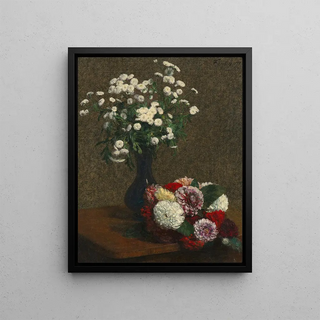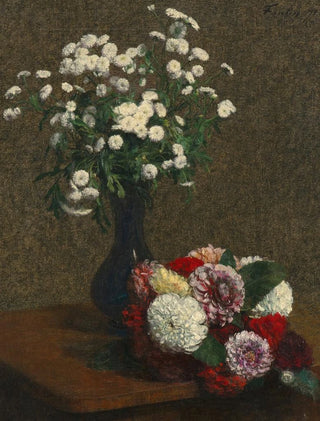Art print | Chamomile and dahlia flowers - Henri Fantin-Latour


View from behind

Frame (optional)
In the enchanting world of floral painting, the artwork "Fleurs camomille et dahlias" by Henri Fantin-Latour stands out for its delicacy and striking realism. This canvas, a true ode to the ephemeral beauty of flowers, transports the viewer to a lush garden, where each petal seems to vibrate under the light. The art print of this iconic piece allows for appreciation not only of the artist's technical virtuosity but also of the emotion it conveys. By contemplating this floral composition, one is invited to explore the nuances of nature while immersing oneself in the soft, poetic atmosphere it emanates.
Style and uniqueness of the work
Henri Fantin-Latour, master of realism, manages to capture the very essence of flowers with remarkable precision. In "Fleurs camomille et dahlias," the richness of colors blends with a harmonious composition, where each element finds its place with elegance. The dahlias, with vivid and varied hues, stand proudly alongside the more discreet chamomile, yet equally charming. The contrast between these two types of flowers highlights the diversity of nature while creating a captivating visual dynamic. The carefully orchestrated light plays a crucial role in this work, revealing the delicate textures of petals and leaves. Every brushstroke seems charged with life, bearing witness to Fantin-Latour's undeniable talent for immortalizing floral beauty.
The artist and his influence
Henri Fantin-Latour, born in 1836 in Grenoble, is an iconic figure of the 19th-century artistic movement. Trained at the École des beaux-arts in Paris, he quickly established himself as a virtuoso of floral painting, but also as a talented portraitist. His work is deeply influenced by Romantic and Impressionist currents, while maintaining a realistic approach unique to him. Fantin-Latour surrounded himself with great artists of his time, such as Claude Monet and Édouard Manet, and participated in numerous exhibitions, contributing to the evolving perception of floral painting.

Matte finish

View from behind

Frame (optional)
In the enchanting world of floral painting, the artwork "Fleurs camomille et dahlias" by Henri Fantin-Latour stands out for its delicacy and striking realism. This canvas, a true ode to the ephemeral beauty of flowers, transports the viewer to a lush garden, where each petal seems to vibrate under the light. The art print of this iconic piece allows for appreciation not only of the artist's technical virtuosity but also of the emotion it conveys. By contemplating this floral composition, one is invited to explore the nuances of nature while immersing oneself in the soft, poetic atmosphere it emanates.
Style and uniqueness of the work
Henri Fantin-Latour, master of realism, manages to capture the very essence of flowers with remarkable precision. In "Fleurs camomille et dahlias," the richness of colors blends with a harmonious composition, where each element finds its place with elegance. The dahlias, with vivid and varied hues, stand proudly alongside the more discreet chamomile, yet equally charming. The contrast between these two types of flowers highlights the diversity of nature while creating a captivating visual dynamic. The carefully orchestrated light plays a crucial role in this work, revealing the delicate textures of petals and leaves. Every brushstroke seems charged with life, bearing witness to Fantin-Latour's undeniable talent for immortalizing floral beauty.
The artist and his influence
Henri Fantin-Latour, born in 1836 in Grenoble, is an iconic figure of the 19th-century artistic movement. Trained at the École des beaux-arts in Paris, he quickly established himself as a virtuoso of floral painting, but also as a talented portraitist. His work is deeply influenced by Romantic and Impressionist currents, while maintaining a realistic approach unique to him. Fantin-Latour surrounded himself with great artists of his time, such as Claude Monet and Édouard Manet, and participated in numerous exhibitions, contributing to the evolving perception of floral painting.






